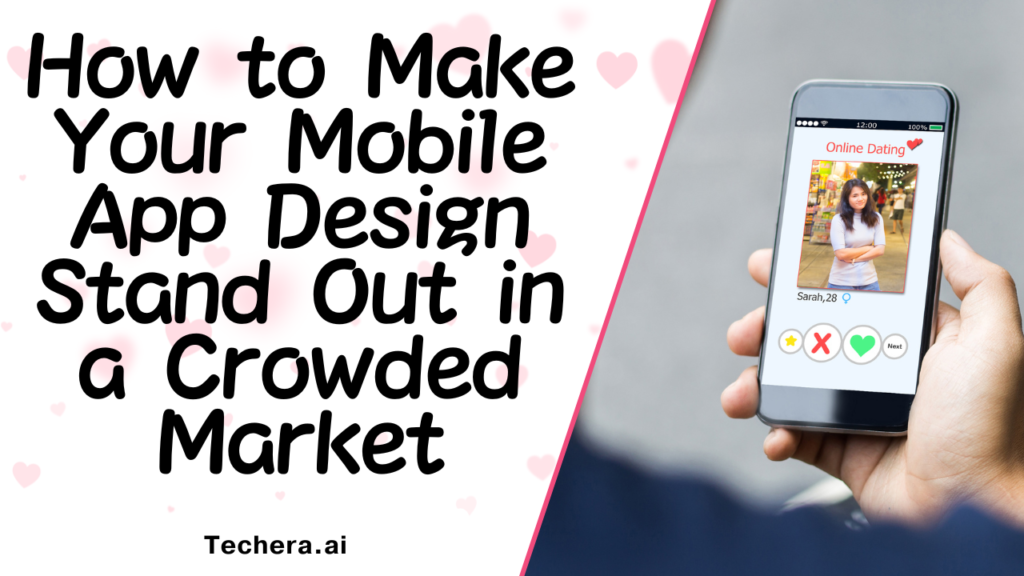
Learn proven tips to elevate your Mobile App Design and capture user attention in today’s competitive market. Discover expert strategies to make your Mobile App Design truly stand out from the crowd.
Introduction
Let’s be real—there are millions of apps out there, and standing out feels like shouting in a stadium full of people doing the same. But what if you didn’t need to shout louder—just smarter? That’s where smart, sharp mobile app design comes in. In this article, we’ll break down how to cut through the noise with a design that not only looks good but feels good to use. Let’s make your app impossible to ignore.
Understanding the Market
Know Your Competition
Before you can stand out, you need to know what you’re up against. Check out the top players in your niche. What’s working for them? What are users complaining about?
Spot the Gaps You Can Fill
Maybe their design is clunky. Maybe onboarding is a nightmare. Find that gap—and fill it with flair.
Define Your Unique Value Proposition (UVP)

What Makes Your App Different?
Is your mobile app design faster? More beautiful? More personal? Whatever your secret sauce is—your design should scream it.
Communicate That Value Visually
Use visual hierarchy, unique illustrations, and strong typography to reflect your brand’s vibe and promise.
Embrace Minimalism with a Purpose
Less Clutter, More Clarity
Don’t overload the screen. Give users space to breathe. Minimal design = maximum clarity.
Make Every Pixel Count
Every button, icon, and image should serve a purpose. If it’s not helping, it’s hurting.
Focus on User-Centered Design
Prioritize the User Journey
Every tap, scroll, and swipe should feel natural. Walk a mile in your users’ shoes—and make it comfy.
Empathy-Driven Interfaces
Design for real humans, not robots. Think about emotions, frustrations, and joy.
Master the Art of Onboarding
First Impressions Matter
You’ve got one shot. Ensure that new users know what your software does and why it matters.
Guide Without Overwhelming
Keep it short, sweet, and interactive. Think tooltips, progress bars, and subtle nudges—not walls of text.
Visual Branding that Pops
Use a Consistent Style Guide
Logo, font, icons—keep it uniform. Consistency builds trust, and trust earns downloads.
Colors, Fonts & Icons that Speak
Your visuals should reflect your brand’s tone. Bold and playful? Soft and professional? Design accordingly.
Leverage Microinteractions
Small Details, Big Engagement
A vibration on tap. A bounce on scroll. A satisfying sound when you complete an action. These small things delight users.
Humanize the Experience
Microinteractions add personality. They make your app feel alive.
Also Read : The Impact of Mobile App Design on Customer Experience
Incorporate Emotional Design
Trigger Positive Feelings
Joy, surprise, satisfaction—design can spark emotions. Use that to your advantage.
Build Connections Beyond Features
People remember how your mobile app design made them feel. Make that memory a good one.
Responsiveness and Speed
No One Likes a Slow App
Lag is the enemy. User satisfaction is maintained by effective design and optimized code.
Optimize for Every Screen
From tiny phones to giant tablets, your design should adapt seamlessly.
Use Motion and Animation Wisely
Guide Attention, Not Distract
Animations should highlight actions, not be a light show. Keep it smooth and functional.
Add Delight Without Delay
Don’t slow the app down for the sake of a fancy effect. Animation should never compromise performance.
A/B Testing for Design Choices

Let the Data Guide You
Think that new menu layout is better? Test it. Data beats opinions.
Test, Measure, Repeat
Great design is a process, not a one-time event. Keep refining based on real user behavior.
Keep Updating and Evolving
Trends Change—So Should Your App
Design trends move fast. Don’t fall behind. Stay fresh, modern, and relevant.
Listen to User Feedback
Your users are talking—read the reviews, track support tickets, and implement changes that matter.
Accessibility Is Not Optional
Inclusive Design = Wider Audience
Design for everyone—visually impaired, hearing impaired, colorblind, and more.
Compliance Builds Credibility
Following accessibility guidelines isn’t just nice—it’s smart business.
Case Studies of Apps That Nailed It
Headspace – Simplicity Meets Emotion
Headspace uses soft colors, calming animations, and minimalist design to create a soothing experience from the start.
Pinterest – Personalized Discovery
Pinterest has a layout that encourages exploration without being overbearing, limitless scrolls, and a personalized user interface.
Conclusion
If you want your app to stand out in today’s overcrowded market, it’s not just about having the best features—it’s about how those features are delivered. A standout design captures attention, keeps users around, and turns them into loyal fans. Start with empathy. Keep it clean. Add personality. Iterate often. Your Mobile App Design deserves to be noticed. Make it unforgettable.
Frequently Asked Question
Q. What makes a mobile app design stand out?
A. A combination of clean visuals, intuitive navigation, emotional connection, and a clear brand identity.
Q. Why is onboarding important in mobile app design?
A. It sets the tone for the user’s entire experience. A seamless onboarding process gives users a sense of control and welcome.
Q. How often should I update my app design?
A. At least once a year—or more often if user feedback suggests it. Design should evolve with user expectations.
Q. What role does accessibility play in app design?
A. It ensures everyone, regardless of ability, can use your app—broadening your reach and improving your brand image.
Q. How do I know if my app design is working?
A. Track metrics like retention, user feedback, and task completion rates. Use A/B testing to experiment and improve.

